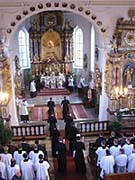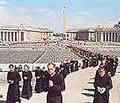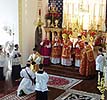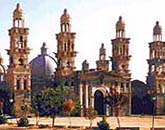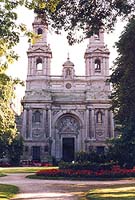The Internet is home to many hundreds of web sites dedicated to the phenomenon of Roman Catholic traditionalism, but all too often those searching for a simple general outline of the movement are left wanting. Traditionalists are factionalised and they have many harsh critics within the mainstream Church, as a result it can be very difficult to find straightforward unbiased information dealing with the movement as a whole. The purpose of this small web site is to fill the void, provide a simple and above all impartial outline of the entire movement, and enable newcomers to read on with perspective and greater understanding. Catholics should find most of the information here straightforward and easy to follow, non-Catholics might find it useful to look over some Catholic basics first.
Over the past year there has been a great influx of interest in traditionalist Catholics as a result of the publicity surrounding Mel Gibson, his film, The Passion of the Christ, and publicity surrounding his father, Hutton Gibson. Although many of the secular news articles that have appeared of late have contained glaring errors and misrepresentations of the traditional movement, some have provided insights and may be of interest to certain readers. In a new section, News & Views, you can find a selection of recent news articles and related information regarding traditional Catholics, Gibson, and the film.
Between 1962 and 1965 the bishops of the Catholic Church met for the Second Vatican Council. Vatican II was a revolutionary council that initiated a great wave of change within the Church. Traditionalism is a movement of conservatism that has emerged as a result of this change. Its proponents have sought to retain, to varying degrees, the beliefs and practices upheld prior to the Council. Some do so because they believe the post-conciliar Church has fallen into error, others simply out of preference.
In 2,000 years of Church history only twenty full ecumenical councils had ever previously been called, and these only when the Church faced a perilous situation—usually the threat of heresy. Vatican II was like no other, it was called on the pretext that the Church needed an "update" to "open the windows to the world" as the council’s convener, John XXIII, put it. The Council certainly did open the windows on the world and in rushed a veritable whirlwind effecting nothing short of a revolution within the Church. Hundreds of books charting the changes have been written over the past 40 years, but for a brief look at some of the principle changes, click here: The Changes. Within the traditionalist movement we can distinguish roughly three principle factions. The task of analysing them is by no means straightforward—there are different shades of opinion within each of them, they are often known by different names, indeed some claim that they alone are truly Catholic. For purposes of clarity we shall avoid at least some of these complications at this web site. Firstly all three factions shall be treated equally as Catholic, and secondly each shall be referred to by its commonest name, these are Indult, Independent, and Sedevacantist.
The Indult faction is made up of those Catholics who are concerned primarily with the changes made to the Mass following the Second Vatican Council. 'Indult' is a legal term meaning a special permission granted by the pope to deviate from the common law of the Church. In 1984 John-Paul II granted one such indult for the continued use of the traditional Latin Mass throughout the Church in the document Quattor Abhinc Annos. Inquiries had been made over the preceding years into the issue of Catholics remaining attached to the old rite of Mass in spite of the reforms which followed Vatican II. The results confirmed that many Catholics indeed still desired the old Mass, and as a result John-Paul II permitted its continued use, but under tight restrictions. Quattor Abhinc Annos specified, for instance, that parish churches must not be used for the celebration of the old Mass, that explicit permission must first be granted by one's local bishop, and that Catholics attending these Masses must in no way question the legitimacy of the reformed rite of Mass. The initial results were limited. Between 1984 and 1988 hardly any bishops gave approval for the old Mass, and those that did granted permission on an infrequent basis alone, perhaps once or twice a year. But in 1988, following a controversial turn of events in a large independent traditionalist society (see below), a great deal changed. John-Paul was compelled to press for a much broader usage of the indult throughout the Church. In the document Ecclesia Dei Adflica of that year he reiterated that permission already existed for the use of the old Mass, that respect must everywhere be shown for Catholics who desired it, and he calling on all the bishops of the Church to utilise the indult "widely and generously." Several bishops complied and many more Masses have since been approved, but to this day many bishops throughout the Church have remained hostile and restrictive.
Indult Masses are usually celebrated by regular diocesan priests in regular diocesan churches. These priests simply offer occasional old Masses in addition to Masses celebrated according in the reformed post-conciliar rite. However, since 1988 a handful of priestly fraternities and religious communities dedicated solely to the old Mass have also emerged. These groups are permitted not only the use of the old Mass; in addition they may use other elements of the pre-Vatican II liturgy—they may, for example, bless, baptise, hear confessions, and pray the breviary in the traditional manner. In most cases dedicated priests are simply attached to regular parish churches where they function as curates alongside fellow priests using the new liturgy, but in a few parts of the world dedicated churches have also been established. Religious communities — nuns, monks, friars, etc. — are generally unmixed. Due to their communal nature they have nearly all been permitted the use of dedicated premises. On matters theological Rome has stated that supporters of the indult must not question the legitimacy of the new Mass. Officially-speaking the indult is merely a liturgical concession granted to certain Catholics who have a personal attachment to the old rite of Mass—it is in no way a license to reject or criticise the new Mass, Vatican II, or the various post-Vatican II changes in the Church. For most indult supporters this is not a problem. Most have nothing more than a personal preference for the old Mass and they are largely indifferent to the other changes in the Church. However, many involved in the indult movement are indeed critical of the modern liturgy, Vatican II, and many post-Vatican II changes. Many believe, for instance, that various forms of error and heresy have infected the Church over the last century, that Vatican II was a disaster, and that the modern liturgy is a travesty. As we shall see, these latter share many of the same views as those in the independent faction.
Further to the right on the theological spectrum is the independent faction. This faction consists of all those who, in reaction to the changes since Vatican II, have felt compelled to operate separately from the mainstream Church. Their situation is something like that of a police force with its own separate and independent stations set up within the jurisdiction of the official police force. Independent traditionalists set up their own chapels, churches, seminaries, monasteries, and schools in Catholic dioceses throughout the world, and they operate them independently of the mainstream Church having no contact with local hierarchies. While they do acknowledge John-Paul II and most of his brother bishops as Catholic, they refuse to follow or obey them in matters liturgical, Vatican II, and the many post-Vatican II changes in the Church. To return to the police analogy, their position is somewhat like a group of police officers who feel compelled to disobey their superiors and operate in parallel to them on the grounds that the former are advancing new wrongheaded directives and failing to fulfil their duties. Independent traditionalists believe they are maintaining the unadulterated Catholic faith with no mingling of error—something that the mainstream Church since Vatican II has continually failed to do. As in all three traditionalist camps there are many shades of opinion within the faction and they are often very hard to pin down, but they are all largely united in the belief that:
Independent traditionalists therefore celebrate the old liturgy and teach and practice the faith in largely the same manner both were carried out prior to Vatican II. Most believe that the Church is currently in a state of crisis. They believe that most Catholics, especially those occupying the highest offices of the Church, have been infected by liberalism, the heresy of "Modernism" (a heresy vehemently condemned by Pope St. Pius X at the beginning of the 20th century), and other suchlike errors. As to Vatican II, most believe liberals and modernists took advantage of John XXIII's naively optimistic "open window" and hijacked the council. However, they are careful to point out that, unlike all previous twenty councils of the Church, Vatican II contained no infallible dogmatic teachings; the council was purely 'pastoral' and non-dogmatic, they maintain, and therefore to reject some or all of it in no way compromises their Catholicity. To demonstrate that the crisis in today's Church is by no means unique, independent traditionalists commonly point to the situation in the Church of the 4th century. At that time the majority of the Church fell into the heresy of Arianism. Most bishops adopted the error of the heresiarch Arias who believed that Christ was a mere man and in no way divine, whereas those who maintained the orthodox belief that Christ was indeed divine were ostracised. But non-Arians were later vindicated by history when the Church explicitly condemned Arianism. Indeed the great champion of orthodoxy, Bishop Athanasius of Alexandria, was excommunicated at the time but later received sainthood for his fidelity and is now honoured as one of the thirty-three doctors of the Church. The late Archbishop Marcel Lefebvre and his Society of Saint Pius X who are arguably the best known of all traditionalists fall into the independent category. The Archbishop and the S.S.P.X. were the stimulus behind John-Paul II's 1988 document Ecclesia Dei Adflica. Lefebvre founded the S.S.P.X. in 1969 in reaction to the changes taking place primarily in the Church's seminaries. The Society grew and spread rapidly throughout the world, but the Archbishop was already past retirement age, he was worried about his failing health, and he no longer posessed the strength to travel across the world ordaining priests and administering confirmations. In 1988 he decided he must consecrate four more bishops for the Society. But he did not receive a papal mandate, which, according to canon law, is a serious offence. As a result, John-Paul deduced that Lefebvre and his bishops had auto-excommunicated themselves and fallen into schism. This is a complex canonical subject, and, as any quick search on the Internet will demonstrate, even today it is still a hotly debated topic.
Furthest to the right on the theological spectrum is Sedevacantism. "Sedevacantism" is a neologism derived from the term "sede vacante" which is Latin for 'see vacant'. Under normal circumstances a Catholic diocese (or 'see') is said to be sede vacante when there is no resident bishop, which can be, e.g., when the local bishop has died and one is yet to be appointed; in such instances official diocesan correspondences carry the words sede vacante in place of the bishop's name. Sedevacantists take the most uncompromising position out of all three traditionalist factions. They believe that the Holy See of Rome is presently vacant—they believe that there is presently no true bishop of Rome, no pope, and that John-Paul II along with one or more of his predecessors (John XXIII, Paul VI, John-Paul I) is a false pope or 'antipope'. Reasons for taking this position vary. Some do so because they believe John XXIII’s election was invalidly manipulated, some believe Paul VI’s election was manipulated, and some even go so far as to claim that Paul VI was abducted and replaced by a Freemasonic impostor. The vast majority, however, believe that the Holy See is vacant because neither of the conciliar 'popes' has been a genuine Catholic. The logic goes something like this:
Most Sedevacantists believe all the conciliar 'popes' to have been heretics (and therefore non-Catholics) of a modernist and liberal bent, many also believe several of them have been freemasonic infiltrators set on destroying the Church from within. Sedevacantists also tend to take the most uncompromising position on the Second Vatican Council and the mainstream Church of today as a whole. Regarding the council, most do not merely claim that the conciliar documents were ambiguous and questionable as do the independent traditionalists; most claim the Council was utterly bogus since it was called by an antipope. As for the mainstream Church of today, most believe it to be, in reality, a heretical non-Catholic schismatic sect. They believe that the genuine Church is comprised of Sedevacantists who have held unfalteringly to the traditional unchanging Faith, while the Church that most people today identify as Catholic is simply a large splinter group which has been led astray by a succession of antipopes. Many doctors and prominent theologians of the Church discussed the theory of a ‘popeless Church’ and the idea that a pope may lose his office by heresy in previous centuries—St. Roberto Bellarmino being perhaps the most famous among them. Opponents of Sedevacantism, however, point out that the private theories of theologians and even doctors of the Church are not Catholic dogma and therefore no Catholic is bound to hold them. Like independent traditionalists, Sedevacantist also set up their own independent churches, seminaries, schools and other properties within the jurisdiction of the mainstream Church. However, unlike independent traditionalists, obviously they do not acknowledge the mainstream Church as genuinely Catholic and they do not therefore believe John-Paul II, his bishops and his priests, have jurisdiction anyway. Most Sedevacantists believe that, since the Church has now been reduced to little more than a tiny remnant and there does not appear to be any way to restore the hierarchy, we are living in the great apostasy of the end times as prophesied in Holy Scripture (cf., 2 Thessalonians).
Besides the three main traditionalist factions there are also much smaller groups that are sometimes referred to as traditionalists. First of all, there are the Conclavists. These are people who were formerly Sedevacantist but who now believe there is a new pope. There are around twenty people in the world today claiming to be pope besides John-Paul II. Rival papal claimants or antipopes were very common in the Middle Ages and many had substantial followings. These present-day 'popes' however enjoy only very small and insubstantial numbers of followers—most are only attached to one or more small community. "Conclavist" is a neologism derived from 'conclave'. A conclave is a private meeting of cardinals held for the purpose of electing a new pope. Followers of the late Fr. Leonard Feeney—a famous theologian from Boston seminary in North America—are also sometimes referred to as traditionalists. Fr. Feeney's followers claim that he was the original traditionalist since he condemned liberal and modernistic thinking long before Vatican II and long before Archbishop Lefebvre or anybody else. Fr. Feeney took a restrictive view of the Catholic dogma "extra ecclesiam nulla salus" (no salvation outside the Church), and he was excommunicated in the 1953 for calling his Archbishop an heretic and failing to appear in Rome when summoned. Fr. Feeney founded a small band of followers called the Slaves of the Immaculate Heart of Mary in Massachusetts , North America. They too believe that various forms of error and heresy have infected the mainstream Church, and they hold that the Catholic dogma—viz., only Catholics go to heaven—has been perverted. Followers of Feeney are often referred to as Feeneyites. Some have been accepted back into full communion with the mainstream Church, their theology tolerated, while others still operate independently. Fr. Feeney was himself reconciled by Paul VI shortly before he died.
Pan-Traditionalists / Drifters
We have already touched briefly on what might be described as "pan-traditionalists" within Catholic traditionalism. These are individuals who either accept the principles of more than one group and rejecting those of others, who drift around the various traditionalist factions, or who perhaps accept all traditionalist factions and are happy to go to almost any church regardless of its position. Many traditionalists believe that the indult and independent factions both compliment each other. They believe that pressure from "within" and "without" is necessary to effect long-term change, and that pressure from the outside results in more permission being granted for the group on the inside. Some hold that, in time, eventually there will be no need for the group on the "outside," it will have served its purpose since the traditional Latin Mass and the traditional faith will be unrestricted and free. Those who accept all factions often hold that the Church is currently facing a crisis like that experienced within the Church between 1378 and 1415 when there were three papal claimants and it could not be established who was genuinely pope. At that time followers of one claimant would condemn the other as schismatic and vice versa, but in hindsight it must be concluded that the confusion in the Church was such that neither was truly schismatic and that anyone who simply kept the faith regardless of papal adherence was in reality fully Catholic. Some traditionalists attend churches of one position while inwardly holding an entirely different position. They generally do so because there is no other church in their area which has the traditional liturgy, or no other traditionalist clergy who teach the true faith free from modern errors. Occasionally some churches attempt to flush these people out, while others have specific protocols in place to prevent against them. For instance, in the indult movement, officially, priests are supposed to establish that those attending their Masses do not, "call into question the legitimacy and doctrinal exactitude of the Roman Missal promulgated by Pope Paul VI in 1970" (Quattuor abhinc annos). The simplest method of 'flushing out' however is for the priest to simply stand in the pulpit preaching something objectionable to those holding a different position, or simply insisting that those of a different position get up and leave. Thirty years ago when the movement was much smaller and church communities were more manageable "drifters" were less of a problem, but today, since the movement has grown so significantly it is much more difficult to avoid. Generally speaking, nowadays, a small element of "drift" is simply accepted.
There are estimated to be around one billion Catholics worldwide today, meaning Catholics make up around one sixth of the planet. Recent official Vatican figures estimated support of the Society of St. Pius X to be at around one million. Very roughly, this would suggest that the entire Roman Catholic traditionalist world must number somewhere around the six or seven million mark. The biggest groups are indult and independent, which collectively make up about four fifths of the traditionalist movement as a whole, Sedevacantists and other groups make up the remaining fifth. The problem with compiling statistics is that many traditionalists operate so underground that they are virtually unknown. For instance, some Sedevacantists believe there are absolutely no priests left in the world to administer the Sacraments efficaciously. As a result, they simply practice their faith in the home and pray privately; these people are sometimes referred to among Sedevacantists as "Home Aloners". Some traditionalists, particularly some Conclavists, have formed what amounts to little more than strange esoteric cults. These people keep their activities known only to the select few and they divorce themselves from the outside world almost completely.
There are quite a number of networked organisations within each of the three traditionalist factions. In the indult faction the biggest priestly fraternities are the Fraternity of Saint Peter (a splinter group from the S.S.P.X. who reconciled with the mainstream Church in 1988), the Institute of Christ the King, and there is also the International Una Voce Federation for lay people, which was headed until recently by the famous Catholic traditionalist writer Mr Michael Davies. The more critical end of the indult movement is represented by a number of North American periodicals such as The Remnant, Catholic Family News, and Latin Mass Magazine. Within the independent faction, as well as several societies, fraternities, and religious congregations, there are also many purely autonomous churches. However, the biggest and best known organised group within the independent faction is the Society of St. Pius X, in fact the S.S.P.X. is perhaps the best known of all traditionalist groups. Sedevacantist also have organised groups and autonomous churches. The biggest Sedevacantist priestly fraternities are located in North America, these are the Congregation of Mary Immaculate Queen, and the Society of Saint Pius V. Followers of the late Fr. Feeney have a small religious community known as The Slaves of the Immaculate Heart who are also located in North America, they maintain the web site Catholicism.org. As for Conclavists, there are many, a list of links to which are maintained at the Papal Claimants web site. For further general reading, the web sites Trad Central, TheLatinMass.com, and The-Pope.com maintain large selections of links. |
||||||||||||||||||||||||||||||||
Site created: 15 February 2003![]()
Email the author.




